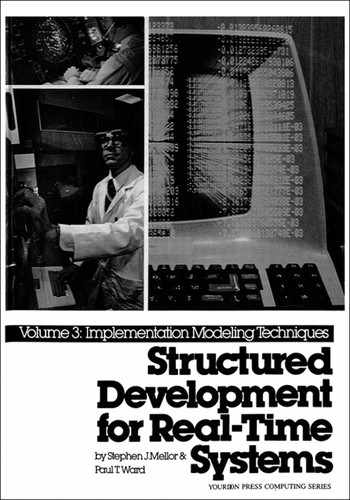0%
25Chapters
0-1Hours read
0kTotal Words
Book Description
In the first two volumes of Structured Development for Real Time Systems, authors Paul Ward and Stephen Mellor described a comprehensive modeling notation and a set of guidelines for using the notation to build an essential model. In this final volume, the guidelines are extended to encompass the building of an implementation model, and the notation is extended to include a hierarchical description of code organization.
Table of Contents
- Copyright
- Yourdon Computing Series: Ed Yourdon, Advisor
- Acknowledgments
- Preface
- Note on Preliminary Edition
- 1. Implementation Modeling Heuristics
- 1. Implementation Modeling Heuristics Overview
- 1.1. Introduction
- 1.2. Minimization of essential model distortion
- 1.3. Satisfactory approximation to essential model behavior
- 1.4. Top-down allocation to implementation technology
- 1.5. Classification of the essential model by use of implementation resources
- 1.6. Data abstraction from the essential model
- 1.7. Conflicts among heuristics
- 1.8. Summary
- Chapter 1: References
- 2. Identifying Implementation Constraints
- 2.1. Introduction
- 2.2. Implementation constraints versus resource availability
- 2.3. Environmental information required to determine constraints
- 2.4. Essential model transformations as sources of implementation constraints
- 2.5. Essential model data as a source of implementation constraints
- 2.6. Summary
- 1. Implementation Modeling Heuristics Overview
- 2. Processor and Task Stage Heuristics
- 3. Processor Modeling
- 4. Task Modeling
- 5. Interface Modeling
- 5.1. Introduction
- 5.2. Synchronization of data flow
- 5.3. Synchronization of access to stored data
- 5.4. Synchronization of control
- 5.5. Net flow of data and interfaces
- 5.6. Interface dialogue flow specification
- 5.7. Modeling control of dialogues
- 5.8. Use of services
- 5.9. Summary
- Chapter 5: References
- 6. Modeling System Services — Process Management
- 7. Modeling System Services — Data Management
- 7.1. Introduction
- 7.2. Stored data management technology
- 7.3. Data independence and binding
- 7.4. Organization of data
- 7.5. Advantages of an external relational view
- 7.6. Run-time database manipulation operations
- 7.7. Constructing relational tables in primary memory
- 7.8. Speeding access to stored data
- 7.9. Distributed databases
- 7.10. Summary
- Chapter 7: References
- 3. Module Stage Tools and Heuristics
- 4. Before and Beyond the Implementation Model
- A. Cruise Control System
- B. Bottle Filling System
- C. SILLY System (Science and Industry Little Logic Yzer)
- D. Defect Inspection System
